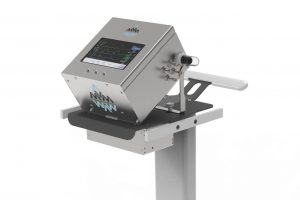More than 3,500 researchers from around the world collaborate with the U.S. Department of Energy’s Fermi National Accelerator Laboratory to develop state-of-the-art technologies and solve the mysteries of matter, energy, space and time.
Here is a look at 10 ways Fermilab advanced science and technology in 2020.
Fermilab and its partners …
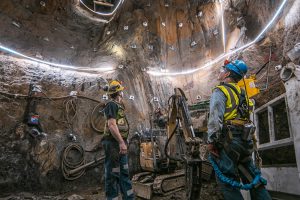 1. Moved earth, rock and data to advance the ultimate neutrino experiment
1. Moved earth, rock and data to advance the ultimate neutrino experiment
Construction is underway for Fermilab’s Long-Baseline Neutrino Facility, which will host the international Deep Underground Neutrino Experiment. This fall, the LBNF team completed the construction prep work on the Fermilab site, where they relocated utilities and completed other work to ready the site for the construction of the LBNF neutrino beamline. In South Dakota, construction crews set off the first blasts to remove rock and are building the rock transportation system (which crosses a highway) in preparation for the main cavern excavation that will start next year. In February, DUNE scientists and engineers completed the blueprint for the gigantic neutrino detector modules that will be installed in South Dakota. They are developing the electronics for the detector, advancing plans for the computing network that will handle the onslaught of DUNE data, and testing components for the detector using ICEBERG, the new testing facility for DUNE at Fermilab. In December, they published their first scientific paper using data collected with a prototype detector at the European research center CERN. A new website explains how DUNE will solve some of the biggest questions regarding the origin of matter and the nature of subatomic particles. The Faces of DUNE project, which wrapped up in February, highlights many of the more than 1,000 collaborators working on DUNE. Many DUNE physicists participated in the 29th International Conference on Neutrino Physics, known as Neutrino 2020, the largest gathering of neutrino scientists in the world. The conference was hosted jointly by Fermilab and the University of Minnesota. Videos and recordings of plenary talks are available online at the Neutrino 2020 website.
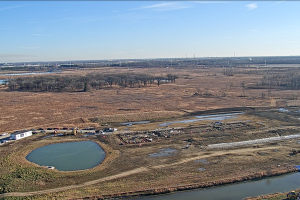 2. Started construction of the first building for the new PIP-II particle accelerator
2. Started construction of the first building for the new PIP-II particle accelerator
In July, the PIP-II team broke ground for the first building of what will become the new heart of Fermilab’s particle accelerator complex: a 215-meter-long, state-of-the-art proton accelerator. You can follow the construction progress with this webcam. The new building will house the cryoplant that will provide the liquid helium for the superconducting section of the accelerator. In October, the PIP-II team successfully accelerated first beam through a key portion of the superconducting section of the PIP-II Injector Test facility. A video released this summer explains how the particle accelerator works. It also highlights the major contributions the project receives from its partners in France, India, Italy, Poland, the United Kingdom and the United States.
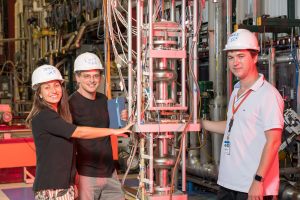 3. Advanced quantum science and received funding for a new quantum center
3. Advanced quantum science and received funding for a new quantum center
The Department of Energy selected Fermilab to lead and host one of five national centers for quantum information science. The Superconducting Quantum Science and Materials Center will bring about transformational advances through a unique multidisciplinary collaboration with 20 partners, including Rigetti Computing, Northwestern University, Ames Laboratory, NASA and INFN. At the heart of SQMS research will be solving one of the most pressing problems in quantum information science: the length of time that a qubit, the basic element of a quantum computer, can maintain information, also called quantum coherence. Research at Fermilab indicates that particle accelerator technology known as superconducting RF cavities could solve this vexing problem. One of the goals of SQMS is to build a quantum computer prototype in the largest millikelvin refrigerator — a millikelvin fridge for quantum devices — ever built. In a separate effort, Fermilab also plays a key role in another center — the Quantum Science Center at Oak Ridge National Laboratory. Fermilab also is part of DOE’s plans for a quantum internet, unveiled at an event in Chicago in July. In 2017, Fermilab planted the seeds for a future quantum internet with the installation of the Fermilab Quantum Network, or FQNET, a long-term partnership with AT&T, Caltech and Fermilab. Fermilab and its partners, with the IEQNET project, are now expanding the point-to-point communications system to a multinode, multiuser network that will crisscross Chicagoland. You can learn more about this burgeoning area of quantum information science and how Fermilab is advancing this exciting field with this collection of articles.
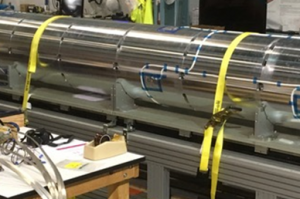 4. Set records by building the world’s strongest accelerator magnets
4. Set records by building the world’s strongest accelerator magnets
Powerful niobium-tin superconducting magnets are key components of high-energy proton accelerators and have applications in many other areas, including medical imaging. In a multiyear effort involving Fermilab, Brookhaven and Berkeley national laboratories, researchers developed technologies and successfully designed, built and tested the first of 16 powerful beam focusing magnets the labs will provide for the High-Luminosity Large Hadron Collider at CERN. The collaboration set a world record for the highest field strength ever recorded in a focusing magnet, reaching up to 13 teslas. In a separate effort, Fermilab and its partners in the U.S. Magnet Development Program are developing steering magnets for a potential successor to the LHC. In 2020, a new magnet set the world record for the highest field strength for a steering magnet, achieving 14.5 teslas. The records add to Fermilab’s long list of achievements in the field of accelerator magnet technologies and confirm that Fermilab and its partners in northern Illinois flourish as a hub for accelerator research and development.
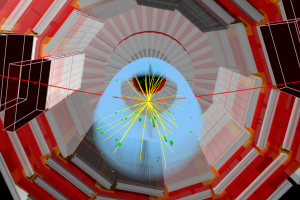 5. Observed a rare Higgs decay and pushed technology to prepare for a flood of new LHC data
5. Observed a rare Higgs decay and pushed technology to prepare for a flood of new LHC data
This year, scientists around the world celebrated 10 years of research at the Large Hadron Collider. Their most famous discovery has been the observation of the Higgs particle by the ATLAS and CMS experiments in 2012, offering a giant leap in our understanding of how particles acquire mass. Yet there is still much to be understood about the Higgs and how the universe works. Having received approval from DOE on the design and schedule of upgrades to the CMS detector, the CMS collaboration reached a milestone in June: the publication of their 1,000th research paper, followed two months later by the announcement of the first indications of a rare process in which the Higgs boson decays into a pair of muons. Future discoveries will be made possible by increasing the number of particle collisions, better particle detector technology — innovative trackers, calorimeters and trigger systems, as well as a new timing detector that can handle 30 billion pictures a second — and advances in computing power and analysis techniques such as graph neural networks and solid-state technology in accessing stored data. In October, the U.S. Department of Energy recognized the LHC CMS Detector Upgrade Project, led by Fermilab, with a Project Management Achievement Award.
6. Helped in the fight against COVID-19 using particle physics know-how
This spring, when the coronavirus began to spread rapidly and the need for the production of mechanical ventilators became apparent, Fermilab scientists volunteered their time to help build a device for delicate lungs. They joined a team of physicists and engineers from Canada, France, Italy and the U.S. to help find a solution. Together, they took a simplified ventilator design from concept all the way through Emergency Use Authorization approval by the U.S. Food and Drug Administration in a little over a month. A few weeks later, Canada ordered the first 10,000 ventilators based on the design. Fermilab also joined the fight against COVID using computing power, together with its partners in the Open Science Grid. As part of the network’s unified response, scientists and engineers at Fermilab spurred themselves into high gear, preparing computing clusters as COVID-19 research machines. Fermilab contributed millions of core hours to pandemic-fighting efforts such as Folding@home, which simulates how viral proteins fold to help scientists design better therapeutics.
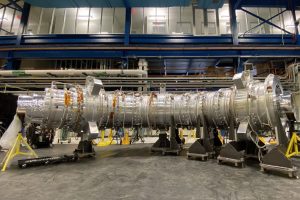 7. Completed key components for the construction of the Mu2e experiment
7. Completed key components for the construction of the Mu2e experiment
The Mu2e experiment at Fermilab will test one of the fundamental symmetries in particle physics by looking for the direct conversion of a muon into an electron. The observation of this process would break the Standard Model wide open, demonstrating that one charged lepton can convert directly into another — a theorized process no one has ever witnessed. Construction of the experiment is underway, and the project has reached 80% overall completion. This fall, the project team successfully tested a crucial section of magnets for the experiment, including components from Italy, Japan and the United States. Work on the target that will produce the muons is proceeding as well, including the robots that will replace the target. The experiment will start up in 2023. When operational, Mu2e will reach 10,000 times the sensitivity of previous experiments.
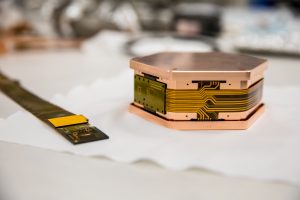 8. Pushed the boundaries of technology to search for dark matter
8. Pushed the boundaries of technology to search for dark matter
Dark matter is one of the most mysterious substances in the universe. It influences the shape and motion of galaxies, yet we don’t know what it is made of. Although it exerts a gravitational force, other interactions of dark matter with ordinary matter have never been observed. Scientists at Fermilab hope to change that. Whether chilling their particle sensors to millikelvins or reducing noise by using Skipper-CCDs, they are pushing the boundaries of technology to discover the collision of a dark matter particle with an ordinary atom. And while dark matter particles have remained elusive so far, the advances in this detector technology have applications in other fields of science.
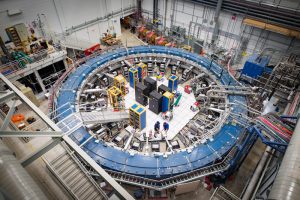 9. Published more than 580 scientific papers (and counting)
9. Published more than 580 scientific papers (and counting)
In 2020, Fermilab scientists were co-authors of more than 580 scientific papers, advancing our understanding of energy, matter, space and time and the technologies that drive these discoveries. The top achievements include the world-leading results in the search for sub-GeV dark matter particles (Physical Review Letters) by the SENSEI collaboration; the world-leading efforts in developing teleportation systems that bring us closer to the quantum internet (PRX Quantum); the world’s most precise calculation of the theoretical prediction for the magnetic moment of the muon (arXiv), a quantity soon to be tested by the Muon g-2 experiment; and a very long single photon lifetime in a superconducting cavity of two seconds (Physical Review Applied).
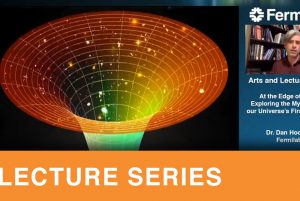 10. Focused on equity, diversity and inclusion and delivered STEM to households near and far
10. Focused on equity, diversity and inclusion and delivered STEM to households near and far
Making our lab a welcoming and equitable place for everyone engaged in our mission of scientific discovery is a top priority. To make progress towards this goal, Fermilab created the position of Chief Equity, Diversity and Inclusion Officer and hired two EDI Office staff members with the goal of making Fermilab a leader within the national lab system and the physics community. The Office of Education and Public Engagement expanded its offerings of online science education programs in 2020. For example, the lab’s Saturday Morning Physics program and STEM career fair were held entirely online for the first time. Live events such as the Arts and Lecture at Home series have attracted viewers from around the world. Ten thousands have watched the lectures live and on YouTube, and thousands have signed up to receive the newsletter with the latest offerings. The Fermilab YouTube channel also published over 30 episodes of the Subatomic Stories series. More than 470,000 people have subscribed to the Fermilab channel. Have you?
Fermilab is supported by the Office of Science of the U.S. Department of Energy.
The Office of Science is the single largest supporter of basic research in the physical sciences in the United States and is working to address some of the most pressing challenges of our time. For more information, visit science.energy.gov.




